Molecules and compounds
Atoms are the smallest units of matter that still retain the fundamental chemical properties of an element. Much of the study of chemistry, however, involves looking at what happens when atoms combine with other atoms to form compounds. A compound is a distinct group of atoms held together by chemical bonds. Just as the structure of the atom is held together by the electrostatic attraction between the positively charged nucleus and the negatively charged electrons surrounding it, the stability within chemical bonds is also due to electrostatic attractions. To illustrate further, consider the two major types of chemical bonds: covalent bonds and ionic bonds. In covalent bonds, two atoms share pairs of electrons, while in ionic bonds, electrons are fully transferred between two atoms so that ions are formed. Let’s consider both types of bonds in detail.
Covalent bonds and molecules
A covalent bond is formed when two atoms share electron pairs. In a covalent bond, the stability of the bond comes from the shared electrostatic attraction between the two positively charged atomic nuclei and the shared, negatively charged electrons between them.

When atoms combine by forming covalent bonds, the resulting collection of atoms is called a molecule. We can therefore say that a molecule is the simplest unit of a covalent compound. As we will now see, there are a variety of different ways to represent and draw molecules.[
Representing molecules: chemical formulas
Chemical formulas, sometimes also called molecular formulas, are the simplest way of representing molecules. In a chemical formula, we use the elemental symbols from the periodic table to indicate which elements are present, and we use subscripts to indicate how many atoms of each element exist within the molecule. For example, a single molecule of NH3, ammonia, contains one nitrogen atom and three hydrogen atoms. By contrast, a single molecule of N2H4, hydrazine, contains two nitrogen atoms and four hydrogen atoms.
Concept check: The chemical formula for acetic acid, a common acid found in vinegar, is C2H4O2. How many oxygen atoms are there in three molecules of acetic acid? 6
As your study of chemistry continues, you will find that sometimes chemists write molecular formulas in different ways. For example, as we just saw, the chemical formula for acetic acid is C2H4O2; however, we will often see it written as CH3COOH. The reason for this second type of formula is that the order in which the atoms are written helps to show the structure of the acetic acid molecule—this is sometimes called the condensed structural formula. As such, we can think of CH3COOH as being like a cross between a chemical formula and a structural formula, which we will consider next.
Representing molecules: structural formulas
Chemical formulas only tell us how many atoms of each element are present in a molecule, but structural formulas also give information about how the atoms are connected in space. In structural formulas, we actually draw the covalent bonds connecting atoms. In the last section, we looked at the chemical formula for ammonia, which is NH3. Now, let’s consider its structural formula:
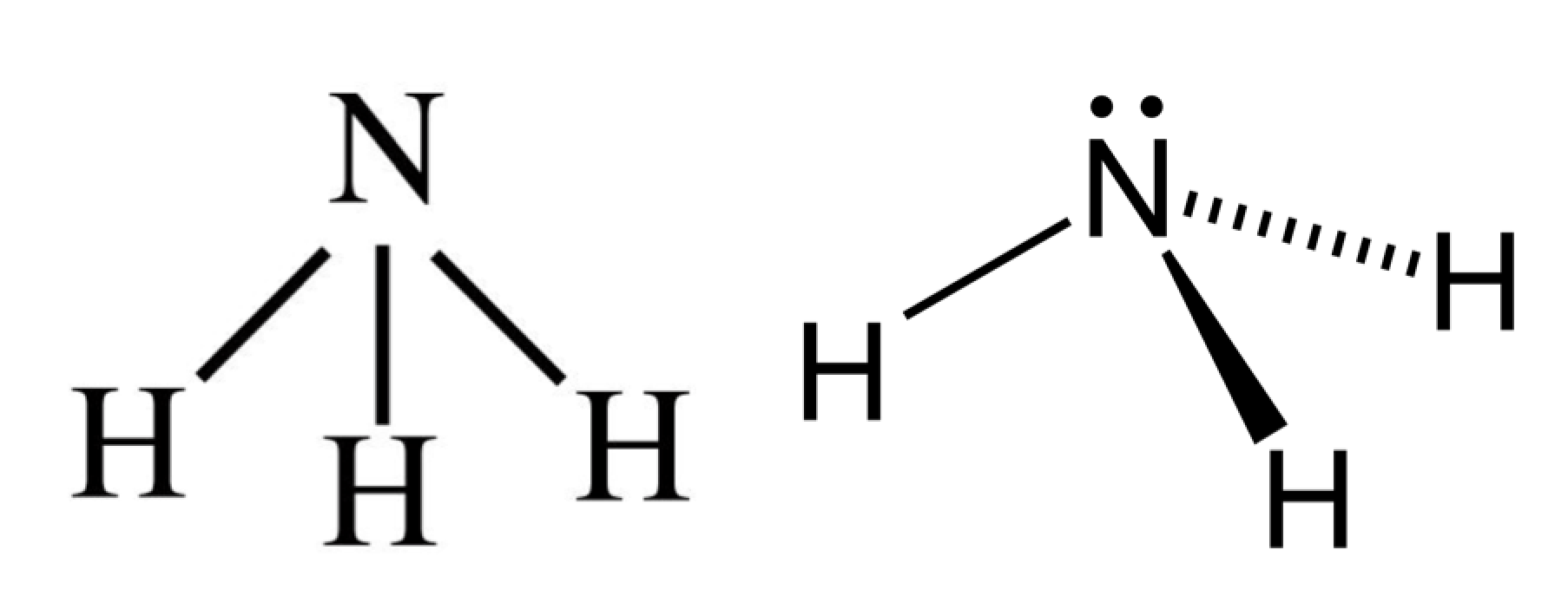
From both of these structural formulas, we can see that the central nitrogen atom is connected to each hydrogen atom by a single covalent bond. Keep in mind, however, that atoms and molecules, just like everything else in the universe, exist in three dimensions—they have length and width, as well as depth. In the structural formula to the left, we are only seeing a two-dimensional approximation of this molecule. However, in the more detailed structural formula on the right, we have a dashed line to indicate that the rightmost hydrogen atom is sitting behind the plane of the screen, while the bold wedge indicates that the center hydrogen is sitting out in front of the plane of the screen. The two dots above nitrogen indicate a lone pair of electrons that are not involved in any covalent bond. We will discuss the significance of these electrons at the end of this section. To help show this three-dimensional shape even more accurately, we can rely on space-filling models as well as ball-and-stick models. Let’s consider both of these models for NH3:
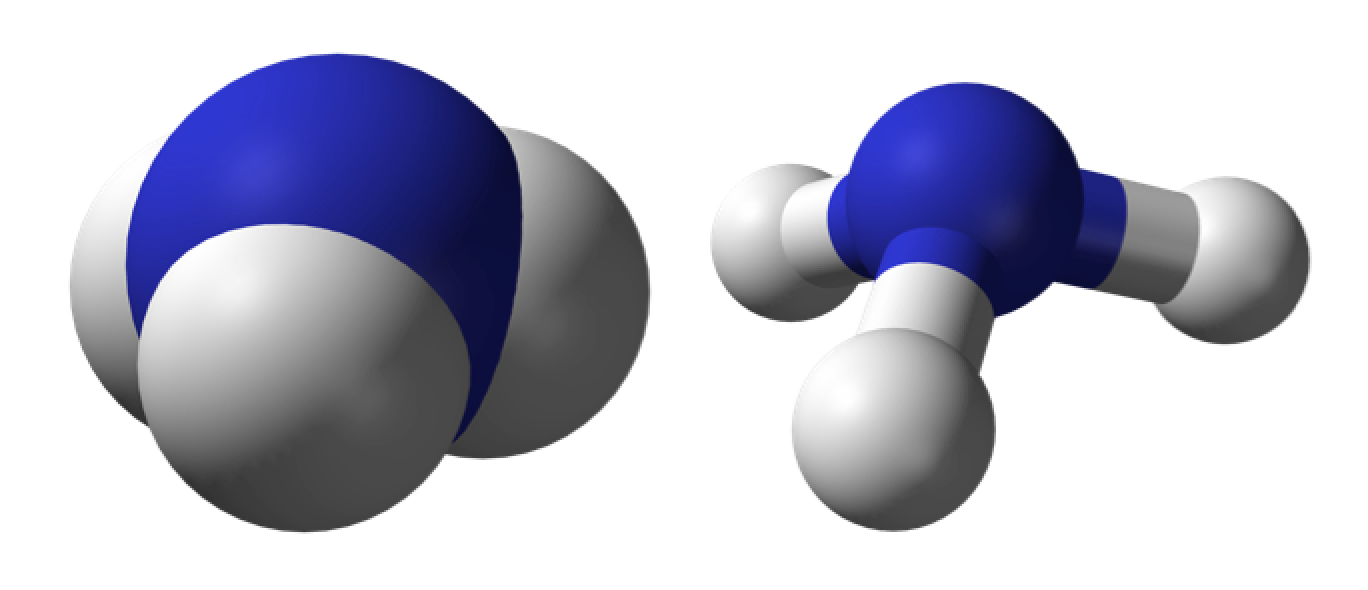
The left-hand image shows the space-filling model for ammonia. The nitrogen atom is depicted as the larger, central blue sphere, and the three hydrogen atoms are depicted as the smaller white spheres off to the sides, which form a kind of tripod. The overall shape of the molecule is a pyramid with nitrogen at the vertex and a triangular base formed by the three hydrogen atoms. As you will learn when you study molecular shapes and molecular geometry, this type of arrangement is known as trigonal pyramidal. The main advantage of the space-filling model is that it gives us a sense of the relative sizes of the different atoms—nitrogen has a larger atomic radius than hydrogen. The right-hand image shows us the ball-and-stick model for ammonia. As you might be able to guess, the balls represent the atoms, and the sticks that connect the balls represent the covalent bonds between the atoms. The advantage of this type of model is that we get to see the covalent bonds, which also allows us to more easily see the geometry of the molecule.
Ions and ion formation
Now that we have an understanding of covalent bonds, we can begin to discuss the other major type of chemical bond—an ionic bond. Unlike covalent bonds, in which electron pairs are shared between atoms, an ionic bond is formed when two oppositely charged ions attract one another. To better illustrate this, we first need to examine the structure and formation of ions.Recall that neutral atoms have an equal number of protons and electrons. The result of this is that the total positive charge of the protons exactly cancels the total negative charge of the electrons, so that the atom itself has an overall charge, or net charge, of zero.However, if an atom gains or loses electrons, the balance between protons and electrons is upset, and the atom becomes an ion—a species with a net charge. Let’s first look at what happens when a neutral atom loses an electron:
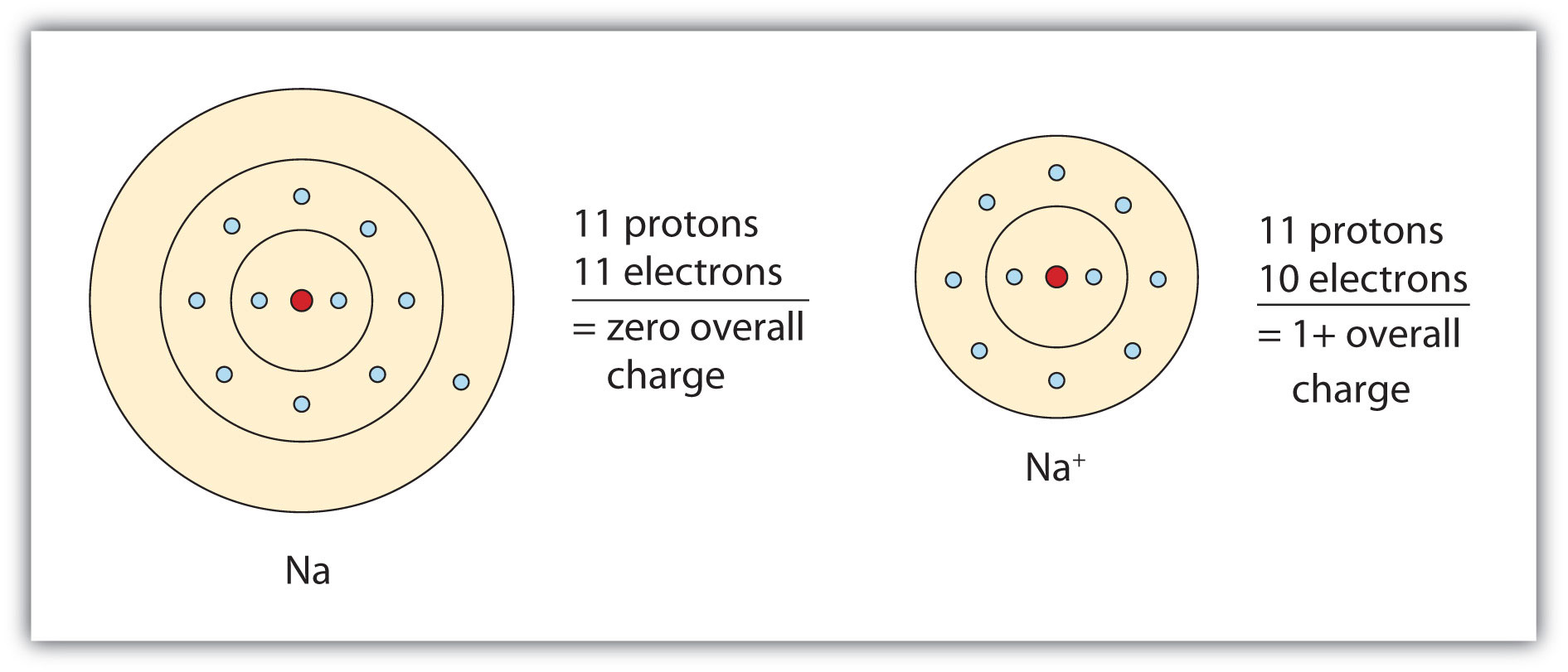
In the diagram above, we see a neutral atom of sodium, Na, losing an electron. The result is that the sodium ion, Na+, has 11 protons, but only 10 electrons. Thus, the sodium ion has a net charge of 1+, and it has become a cation—a positively charged ion. Next, we’ll look at the formation of an anion—an ion with a net negative charge.
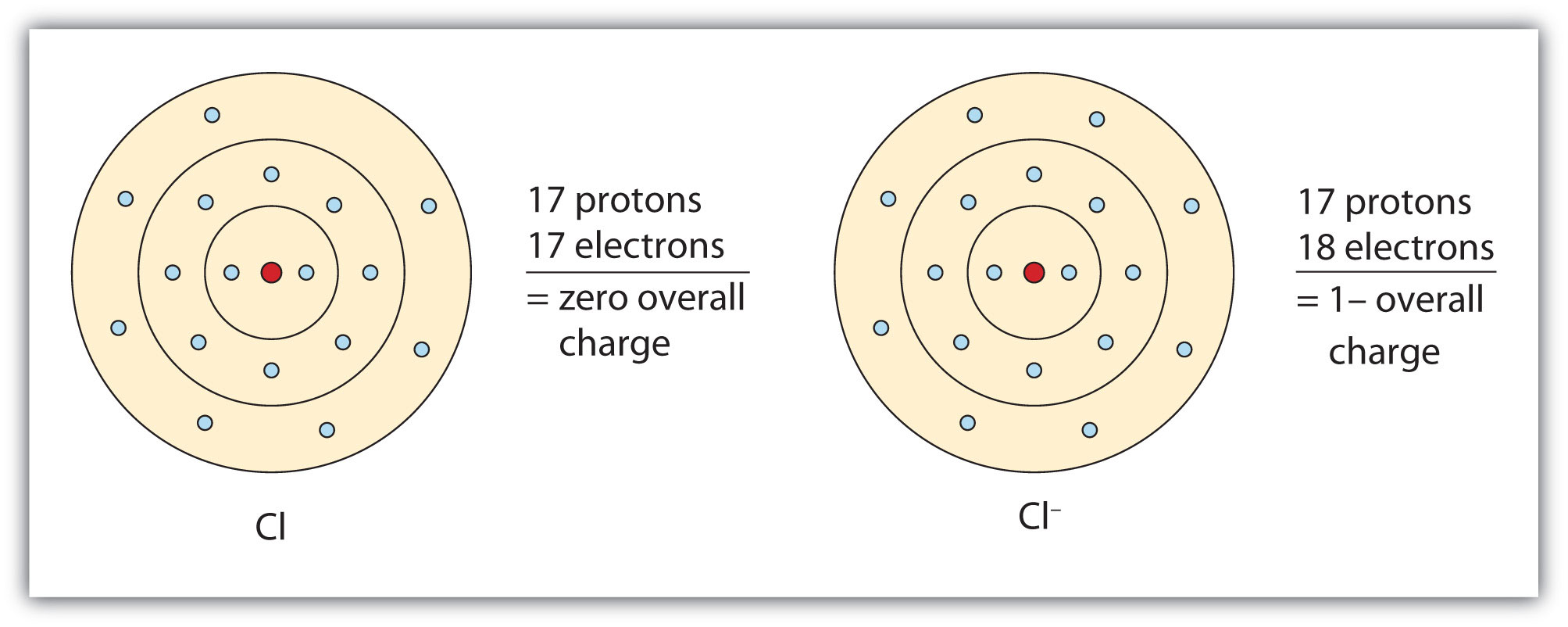
In this diagram, we see the opposite process of what we saw with the sodium atom. Here, a neutral chlorine atom, Cl, is gaining an electron. The result is that the newly formed chloride ion, Cl-, has 17 protons and 18 electrons. Because electrons carry a 1- charge, the net charge on the chloride ion from the extra electron is 1-. It has become an anion, or a negatively charged ion.
Note: When neutral atoms gain electron(s) to form anions, they are typically named with an -ide suffix. For example, Cl- is chloride, Br- is bromide, O2- is oxide, N3- is nitride, etc.
Ionic bonds
In the last section, we looked separately at how sodium can lose an electron to form the cation Na+ and at how chlorine can gain an electron to form the anion Cl-. In reality, however, this process can occur all in one step when sodium gives its electron away to chlorine! We can illustrate this as follows:

Here, we can see how an electron is transferred from sodium to chlorine in order to form the ions Na+ and Cl-. Once these ions are formed, there is a strong electrostatic attraction between them, which leads to the formation of an ionic bond. We can see that one of the major distinguishing factors between ionic bonds and covalent bonds is that in ionic bonds, electrons are completely transferred, whereas in covalent bonds, electrons are shared.
Note: As you learn more about bonding, you will see that in actuality, the difference between covalent and ionic bonds is not black and white and that the two types of bonds are actually more like the two ends of a common spectrum. We can think of a pure ionic bond as having a perfectly unequal sharing of electrons, whereas a pure covalent bond has a perfectly equal sharing of electrons. In reality, however, most chemical bonds lie somewhere in between these two cases.
Drawing ionic bonds
We will now consider the different ways we can draw or depict ionic bonds. We will continue looking at the most commonly known ionic compound—sodium chloride, which is best known as table salt. A single ionic bond in sodium chloride can be shown as follows:
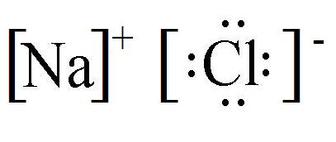
The positively charged sodium cation and the negatively charged chloride anion like to position themselves next to each other due to their mutual electrostatic attraction. Because no electrons are shared, we don’t depict an ionic bond with a line as we do for covalent bonds. We simply recognize that the attraction is there due to the opposite charge signs on the ions. The above diagram, however, is just a model. In nature, sodium chloride does not exist as a single sodium cation bonded with a single chloride anion. As we mentioned earlier, sodium chloride is table salt—and if we were able to use a super-powered microscope that could examine table salt at the atomic level, we would see something like the following structure:
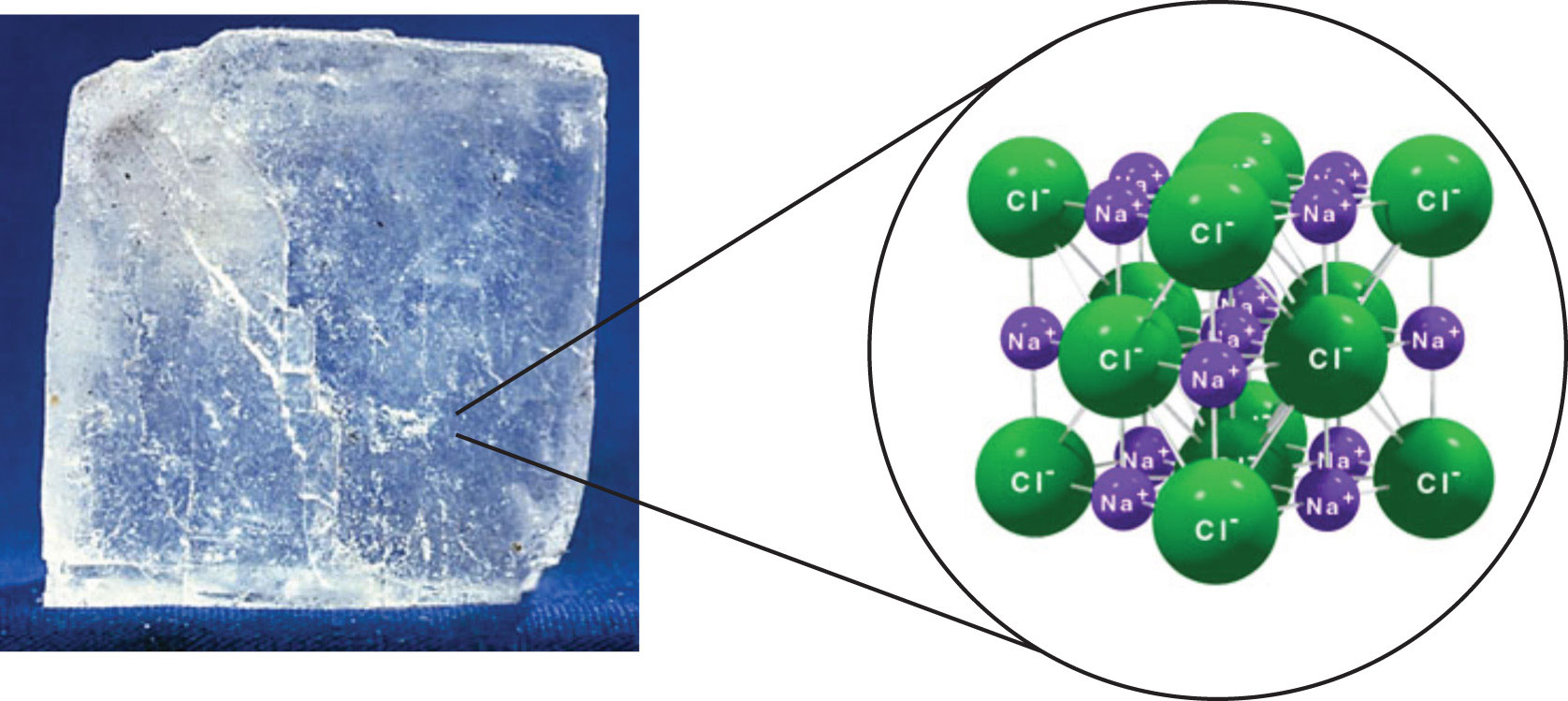
We can see from this diagram that the Na+ and Cl- ions naturally position themselves next to one another in space due to the shared electrostatic attractions between them. The ions are then held in place by their very strong ionic bonds. The above structure is known as a crystal lattice, and sodium chloride—like most ionic compounds—is a crystalline solid. You will learn more about this in future lessons on the different types of solids.
Covalent vs. ionic compounds: molecules vs. formula units
Now that we’ve discussed the basics of both covalent and ionic bonding, we need to draw a few necessary distinctions. We know that a group of atoms joined by only covalent bonds is known as a molecule. It should be noted, however, that the word molecule should only be used in reference to covalent compounds. In an ionic compound, such as sodium chloride, there is no such thing as a single molecule of sodium chloride since, in reality, sodium chloride is actually made up of multiple sodium and chloride ions joined together in a large crystal lattice—as we saw in the previous diagram. As such, we refer to one piece of NaCl not as a molecule but as a formula unit. Keep in mind that single formula units, unlike single molecules, largely do not exist in nature—we simply rely on formula units for ease of reference and convenience.
Concept check: Which type of compounds are composed of molecules—ionic or covalent? Covalent
Conclusion
All chemical bonding is due to electrostatic attraction. When atoms combine through chemical bonding, they form compounds—unique structures composed of two or more atoms. The basic composition of a compound can be indicated using a chemical formula. A chemical formula uses symbols from the periodic table to indicate the types of elements present in a particular compound while using subscripts to represent the number of each type of element present. Compounds can be covalent or ionic. In covalent compounds, atoms form covalent bonds that consist of electron pairs shared between two adjacent atomic nuclei. An example of a covalent compound is ammonia. The chemical formula of ammonia is NH3, which tells us that in a single molecule of ammonia, there is one nitrogen atom, and three hydrogen atoms. The structure of a covalent compound can be depicted through space-filling models as well as ball-and-stick models. In ionic compounds, electrons are completely transferred from one atom to another so that a cation—positively charged ion—and an anion—negatively charged ion—form. The strong electrostatic attraction between adjacent cations and anions is known as an ionic bond. The most common example of an ionic compound is sodium chloride NaCl, better known as table salt. Unlike covalent compounds, there is no such thing as a molecule of an ionic compound. This is because in nature NaCl does not exist in individual units, but in crystal lattice structures that are composed of multiple Na+ and Cl- ions alternating in space. The chemical formula NaCl specifies one formula unit of this compound.
Source: https://www.khanacademy.org/science/chemistry